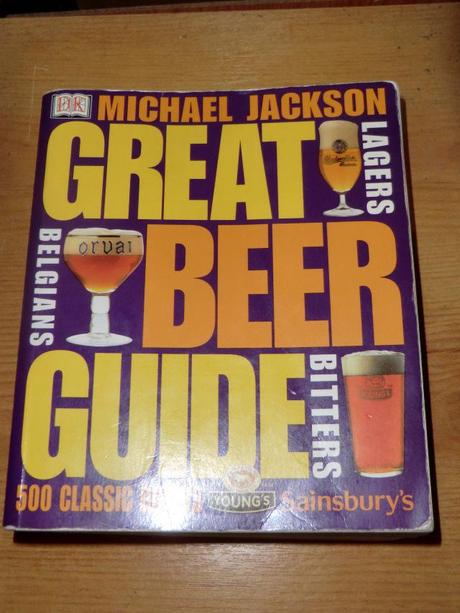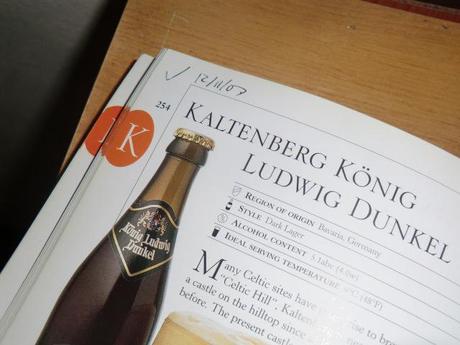
Michael Jackson: Great Beer Guide (Dorling Kindersley: ISBN 0-7513-0813-7)
So, I had probably best get this out of the way first. This is an old book in beer years. About fifteen years old. Since Michael Jackson has passed away it is also fairly unlikely to get a revised edition – to say the least. So we are talking about a book before the big boom in craft beer in UK, Italy, New Zealand and more in recent years. For a beer ticker bucket list book that is a bit of a kick. Roughly a quarter of the beers recommended no longer exist, along with a good chunk of breweries.
So why am I writing about it?
Because this was my first beer book, and still one of the few “Beer Bucket List” books that I have time for. Why? Well let’s take a look.
First up is actually just the physical properties of the book. A lot of beer ticker books, especially the ones with a large number of recommendations, are utter beasts of books. Heavy, hard to flick through, hard to take anywhere. This is a bare five and a half by six and a half inches, though for that it is nearly two inches deep. The smaller size means I can quickly sling it in a bag if I am off beer hunting. Seriously, why are so few beer ticker books designed to be carried when out hunting beers? It is like they design them against being used for their one purpose!
It’s alphabetic, and easy to flick through to find what you are looking for. A lot of books these days organize by beer style, and I can see why, but when out on the hunt alphabetic is much easier to use. Especially with the vagaries of beer styles that can come up these days.
Second is range. Despite the time it was made, it still manages to cover a wide range of countries and style. Germany, UK, Belgium, and USA dominate, but there are early signs of the Italian and NZ scene, and a whole wealth of other countries dipped into. The beers similarly have huge chunks from traditional and new (as they were then) up and comers, Oddities of gose, pine cones beer, tea lambics, French Biere De Garde, Sam Adams super strong bock beers, USA recreations of Adamsbier and British Honey Ales are shown alongside Hefeweizens, British Bitters, Imperial Stouts, Trappist Quadrupels and uber hopped IPAs.
For someone like me, who was just coming into the beer world, this was like a hand grenade. The size of the range (500 beers) was such that I could not remember all of them when wandering, but the mix of images picked and the short description matching meant that quite often I would see a beer and, a short flick later, confirm it was in the book. So many books these days seem to miss off photos for a lot of their beers, so as to fit more beers in, and that just means I am less likely to recognize them, so it just makes for wasted entries and words.
Here, the images are done of both bottle and beer in a glass, helping give an idea of what to look for in a shop, and give a simple visual impression of the beer itself. I still don’t get why so many books get this wrong, this is basic stuff. An image of the beer itself can get across a lot about the beer which no amount of words can capture. The colour, cloudiness, the size and nature of the head, all captured in one photo.
Even better, the book has a guide at the back of useful addresses and websites for organisations, retailers and festivals. Ways to get your hands on the beers listed in the pages before. Again, this book is about drinking good beer, and it does all it can to make that easy. This section covers a quite impressive range of countries, and though out of date now, was of great use in my early days. Similarly the beer description gives not just country, but region where appropriate, making it easier to plan a beer hunt when on holiday, and it also gives an ideal serving temperature for when you find it, as well as the more expected beer style and abv.
Beyond all that however is just the joy of beer – each description is short, to the point and packed with flavor details, and little bits of trivia about the beers and their brewery. It manages to pack in as much to make you interested as many book’s far longer writings. Everything is punchy and each word used to good effect. When you have so many beers listed, such concise way with words is a brilliant way of making more stick in your memory.
So that is why, of all the beer ticker books, despite its age, I keep coming back to this one. Why I am eternally happy to find one of the ones I have yet to find, marking it off on the pages in ink. Because it shares a love of beer, and it knows how to make it easy to use it to find the said beer and enjoy that beer, a fact so many books overlook, becoming instead just heavy pulp to prop up your coffee table.

Now, these days I cannot in good heart recommend this book to newcomers. So many beers don’t exist any more. So many have changed, bought up by big brewery chains and the recipes changed to meet market forces, or more optimistically, so many good new beers and breweries have been birthed since it’s writing.
It is however a book that, if you are going to add to the over saturated glut of beer ticker books on the market, you should look at this first and learn .

